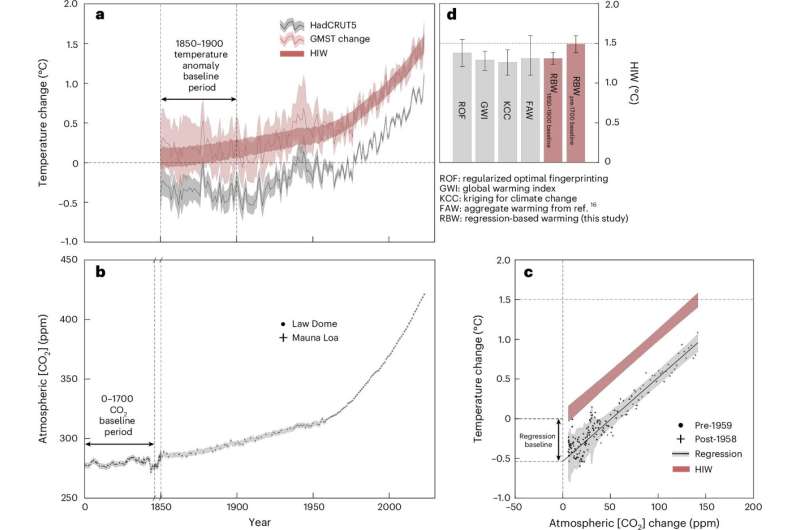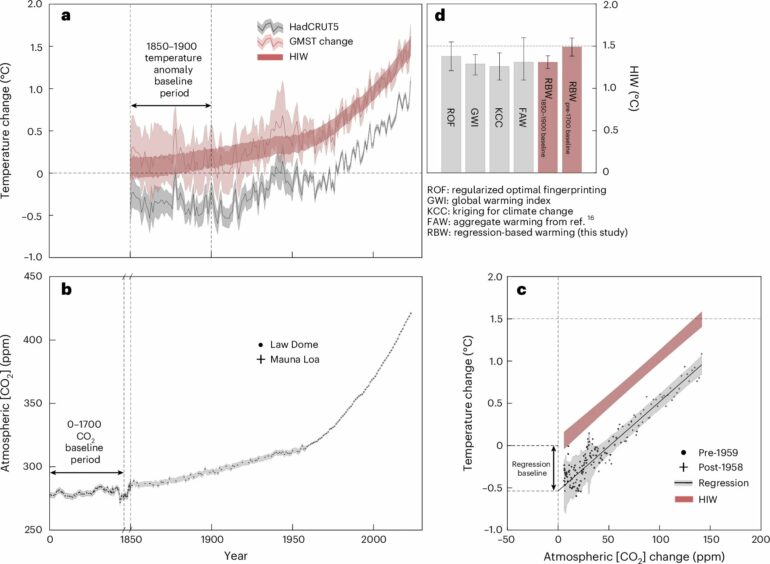A new study published today in Nature Geoscience by Dr. Andrew Jarvis at Lancaster University and Professor Piers Forster at the University of Leeds shows that humans may have already caused 1.5°C of global warming when measured from a time genuinely before the industrial revolution and the start of large-scale carbon emissions.
The Paris Climate Agreement from 2016 established a long-term temperature goal of “limiting global temperature increase well below 2°C, while pursuing efforts to limit the increase to 1.5°.” The 1.5°C of warming figure has since become the yardstick to judge progress, or the lack of it, on climate change.
The human-induced contribution to global warming is currently put at 1.31°C, but with an uncertainty range of 1.10 to 1.60°C, according to the Intergovernmental Panel on Climate Change (IPCC’s) preferred methods. This means it is unclear, from the IPCC’s adopted estimates, whether the 1.5°C boundary has been breached or not.
Crucially, the IPCC’s preferred methods use temperature records from 1850 to 1900 as their “pre-industrial” baseline for their calculations. They do this because this is when the first temperature records were taken, although the exact way to measure global temperature increases has never been defined within the climate negotiations.
Using this same 1850–1900 baseline, Dr. Jarvis and Professor Forster’s method more than halves the uncertainty in the current human-caused warming estimate, thereby showing human-caused global warming currently remains below 1.5°C if measured this way. On this measure, crossing the 1.5°C Paris guardrail is under 10 years away at current warming rates.
However, Dr. Jarvis and Professor Forster go further. Their method makes a more accurate estimate of the true long-term human contribution to global warming by pushing the base period from which the global temperature change is measured back to before 1700.
The authors find that when measured from this earlier, more accurate definition of pre-industrial time, the long-term human contribution to warming was 1.49°C ± 0.11°C in 2023 and is now above 1.5°C. This reveals that there is almost 0.2°C of warming within the 1850–1900 baseline currently being used to define the warming.
Dr. Jarvis, lead author of the study, said, “Measuring human-caused global warming is a difficult task because it forces us to compare today’s temperature with what it was in pre-industrial times—we call this the pre-industrial baseline. The closest we come to pre-industrial global temperature measurements are from the middle of the 1800’s, and unsurprisingly, these data are somewhat patchy and the Industrial Revolution was well underway by then.
“So using these early temperature data as a baseline as previous methods not only ignores the warming that was already underway, it also bakes significant uncertainty into warming estimates.”
This new study instead uses CO2 records from air bubbles trapped in ice-cores to establish a pre-1700 baseline for temperature. These records stretch back thousands of years, well before the Industrial Revolution and the effects of human-derived carbon emissions. The scientists are able to use the CO2 record to anchor global warming estimates because of what they say is an overlooked relationship between the two.

HIW estimates. © Nature Geoscience (2024). DOI: 10.1038/s41561-024-01580-5
“If you plot global temperatures against the concentration of CO2 in the atmosphere, they both fall on a remarkably straight line, much straighter than current theory would predict,” said Dr. Jarvis. “That line tells you not only how much the Earth has warmed since pre-industrial times, but also how much of that warming can be blamed on human activity.
“The climate is unimaginably complex, so perhaps it isn’t so surprising that such a direct method for accurately measuring the warming humans are responsible for has been overlooked,” Dr. Jarvis added.
The scientists believe their new method is a strong candidate for measuring progress against the 1.5° and 2.0° Paris yardsticks.
Dr. Jarvis said, “Our method has a number of strengths. Firstly, it directly tackles the problem of how to establish a robust pre-industrial baseline, although it functions equally well with the 1850–1900 baseline. Secondly, it produces estimates of human-caused warming that are at least 30% more certain than current methods.
“Finally, it is easy and quick to apply, meaning that we can produce warming estimates as soon as the CO2 and temperature data become available without having to re-run complex climate models. This also means the results are transparent, making them far easier to communicate to non-specialists.”
Professor Forster, co-author of the study, said, “Our study shows that human societies have caused more than 1.5° of long-term global warming. However, this does not necessarily mean that the Paris Agreement’s 1.5° temperature guardrail is breached, as we find that 0.18°C of warming happened before global temperature records began, and this baked-in warming would not have been factored into the Paris Agreement.
“Policy makers set the Paris temperature goal to limit the devasting climate impacts many around the world are already experiencing. It was set to push countries to higher national ambition. It is clear we need to do more. The ambition set out in the goal for ‘pursuing efforts to limit the increase to 1.5°’ was not vainglorious when set, rather countries did not match it with their efforts.
“Urgent actions can slow warming rates and push back the time of breaching the Paris 1.5° limit. Although breaching the limit is now inevitable, delivering action commensurate with the noble Paris goal is more important than ever,” he added.
Although useful for measuring current levels of human-induced global warming, the researchers caution against using their method for making predictions on future warming.
Dr. Jarvis, said, “Although atmospheric CO2 is responsible for the bulk of human-induced warming so far, it is not solely responsible, and we know other factors such as methane could become increasingly important in the future, especially if we encounter climate tipping points. This means we need to keep an eye on our analysis. Fortunately, departures from the current linear regime could provide valuable early warning of such a change.”
More information:
Andrew Jarvis et al, Estimated human-induced warming from a linear temperature and atmospheric CO2 relationship, Nature Geoscience (2024). DOI: 10.1038/s41561-024-01580-5. www.nature.com/articles/s41561-024-01580-5
Provided by
Lancaster University
Citation:
Humans have already caused 1.5°C of long-term global warming according to new estimates (2024, November 11)



